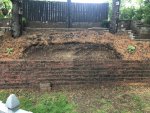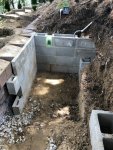- Joined
- Jun 22, 2011
- Messages
- 4,684
- Reaction score
- 3,764
- Hardiness Zone
- 5b
- Country

as others have mentioned; you don't need a heater to have fish, assuming you're looking at koi, goldfish, or something native that doesn't need a river flowing through it. Not to mention, heating a pond in the winter is going to cost you a fortune.
If you're going with concrete blocks, do some research and watch some videos but the basic idea is you'll need to fill the block holes with cement (not mortar; and you should be cementing the blocks, not mortaring them) and every other hole should have re-rod top to bottom. All this said, you'll need to seal the inside. And even then, you may still run the risk of deveoping a leak as mother nature likes to push and pull during the winter. If you're going to go the block route, backfill against the walls with sand.
Too, your pond floor should be cement with wire reinforcement or more re-rod; better if you can integrate the re-rod of the floor into each wall. The idea is this; when you build a house, you have foundation that is below the frost level. And upon this, you build with the blocks (old fashioned) or poured cement. The weight of the house on top helps strengthen the walls against nature's push in the winter and rainy seasons. You don't have this weight to help so your walls will experience sheer forces. The cement and re-rod helps hold it all together but it won't prevent evenutal cracks.
The ideas presented above are tried and true and a lot less problematic for the typical garden variety pond owner. That is, use a liner and it's both easier, cheaper, and more secure than cement ponds.
The tile idea while nice on paper truly will disappoint you in no time, as noted by mrsclem. Algae is going to cover everything and your pond interior will be green. Which isn't something bad; you want this as it is part of your balanced pond--which is your goal. As an example of 'everything's green'; I used two colors of sandstone for my bog wall. Spent a goodly amount of time laying it all out so it looked natural. Didn't take more than a month and every rock was covered with algae. I could have gotten cheaper and easier rock to work with but I was going by what I wanted, not what was going to happen. Tile in a pool is different as you're using chems to keep the algae at bay. In a garden pond, you're going to get algae and like I said, it's the good stuff that clings to everything submerged.
Also, consider your waterfall; most don't look to build the 'volcanoe' type waterfall, which is what will happen to yours if you don't consider the landscaping surrounding the pond. You want to make it gradual and natural. Google some waterfall vids and see some examples of taller waterfalls that don't look like they suddenly erupted out of the flat earth surrounding the pond. Look also at lower falls and see if the ideas work for you.
If you're going with concrete blocks, do some research and watch some videos but the basic idea is you'll need to fill the block holes with cement (not mortar; and you should be cementing the blocks, not mortaring them) and every other hole should have re-rod top to bottom. All this said, you'll need to seal the inside. And even then, you may still run the risk of deveoping a leak as mother nature likes to push and pull during the winter. If you're going to go the block route, backfill against the walls with sand.
Too, your pond floor should be cement with wire reinforcement or more re-rod; better if you can integrate the re-rod of the floor into each wall. The idea is this; when you build a house, you have foundation that is below the frost level. And upon this, you build with the blocks (old fashioned) or poured cement. The weight of the house on top helps strengthen the walls against nature's push in the winter and rainy seasons. You don't have this weight to help so your walls will experience sheer forces. The cement and re-rod helps hold it all together but it won't prevent evenutal cracks.
The ideas presented above are tried and true and a lot less problematic for the typical garden variety pond owner. That is, use a liner and it's both easier, cheaper, and more secure than cement ponds.
The tile idea while nice on paper truly will disappoint you in no time, as noted by mrsclem. Algae is going to cover everything and your pond interior will be green. Which isn't something bad; you want this as it is part of your balanced pond--which is your goal. As an example of 'everything's green'; I used two colors of sandstone for my bog wall. Spent a goodly amount of time laying it all out so it looked natural. Didn't take more than a month and every rock was covered with algae. I could have gotten cheaper and easier rock to work with but I was going by what I wanted, not what was going to happen. Tile in a pool is different as you're using chems to keep the algae at bay. In a garden pond, you're going to get algae and like I said, it's the good stuff that clings to everything submerged.
Also, consider your waterfall; most don't look to build the 'volcanoe' type waterfall, which is what will happen to yours if you don't consider the landscaping surrounding the pond. You want to make it gradual and natural. Google some waterfall vids and see some examples of taller waterfalls that don't look like they suddenly erupted out of the flat earth surrounding the pond. Look also at lower falls and see if the ideas work for you.


